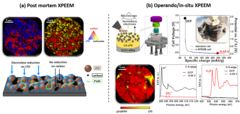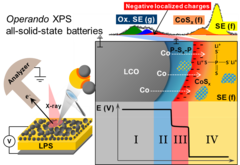Search
Post mortem/operando XPEEM: for studying the surface of single particle in Li-ion battery electrodes
X-ray photoemission electron microscopy (XPEEM) with its excellent spatial resolution is a well-suited technique to elucidate the complex electrode-electrolyte interface reactions in Li-ion batteries. It provides element-specific contrast images and enables the acquisition of local X-ray absorption spectra on single particles. Here we demonstrate the strength of post mortem measurements and we show the first electrochemical cell dedicated for operando experiments in all-solid-state batteries.
Deciphering the Mechanism of FEC-induced SEI Formation in Li-ion Batteries
Fluoroethylene-carbonate is often referred to as a film-forming electrolyte additive for Li-ion batteries, resulting in high quality Solid–Electrolyte-Interphase on negative electrode, however, the underlying mechanism, even if thought to be known, has been only clarified due to our targeted experimental design, combining systematic electrochemical, chemical and microscopy characterization techniques. We have shown that first the formation of inorganic LiF-rich particles appear and only later the carbonate-rich film is actually formed.
Reactivity and potential profile across the electrified LiCoO2-Li3PS4 interface probed by operando X-ray photoelectron spectroscopy
All-solid-state lithium batteries are a promising alternative for next generation of safe energy storage devices, provided that parasitic side reactions and the resulting hindrances in ionic transport at the electrolyte-electrode interface can be overcome. Motivated by the need for a fundamental understanding of such interface, we present here real-time measurements of the (electro-)chemical reactivity and local surface potential at the electrified interface Li3PS4 and LiCoO2 using operando X-ray photoelectron spectroscopy.
Basic course in Electrochemistry (Prof. Dr. Petr Novák, ETHZ)
The basic course in Electrochemistry (given in German) will start in the room HPT C 103 (ETH Campus Hönggerberg) on Monday, September 23, 2019 at 08:45. For further information, please contact PD Dr. Lorenz Gubler, E-mail: Lorenz.Gubler@psi.ch. Download the slides of the lectures here (password-protected): Vorlesung Elektrochemie.
LEC Seminar Archive
Die Seminare finden im Raum ODRA/111 jeweils am Mittwoch um 11:00 Uhr statt. Externe Gäste (ausserhalb des PSI) sind willkommen, werden aber gebeten, sich im Labor-Sekretariat bei Frau Cordelia Gloor unter Tel.: +41 56 310 2919 oder per e-mail anzumelden. Lectures take place in room ODRA/111 on every Wednesday at 11:00 am. External guests (from outside PSI) are welcome, but are requested to register with our secretary Cordelia Gloor at phone: +41 56 310 2919 or via e-mail.



